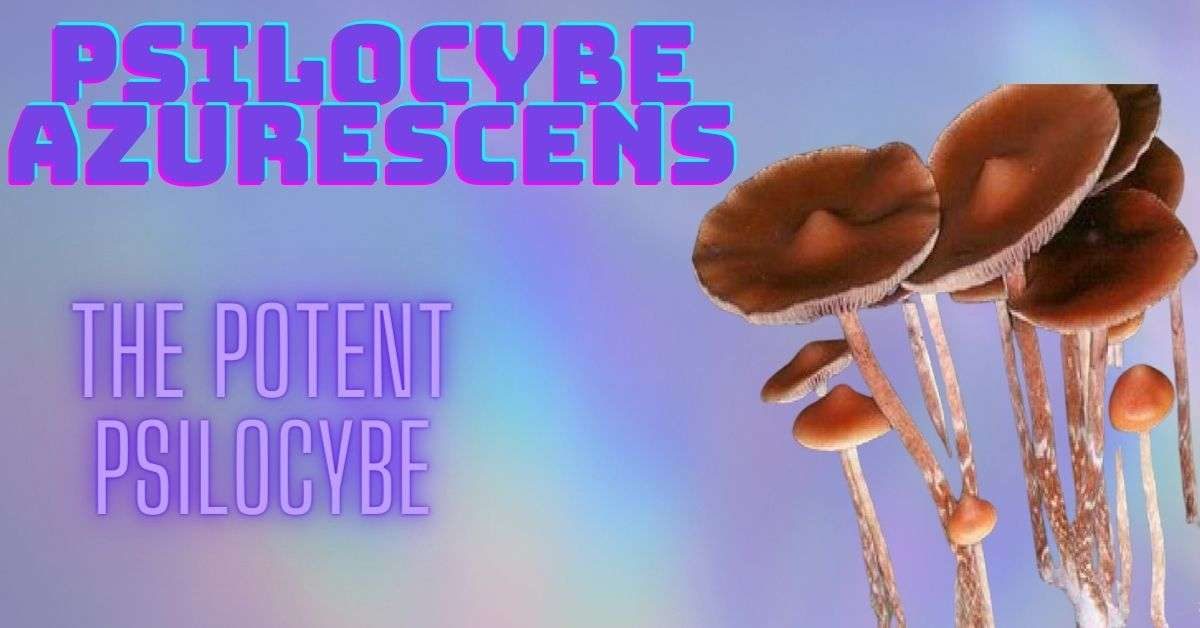Psilocybe Azurescens is a type of psychedelic mushroom that has become increasingly popular among those interested in the psychoactive effects produced by various fungi. This article will explore Psilocybe Azurescens’ characteristics, active compound content, and potential therapeutic benefits.
Discovery Of This Magic Mushroom
Psilocybe Azurescens was first discovered in 1979 by Paul Stamets near Astoria, Oregon, and has since become renowned for its potency compared to other psilocybin mushrooms. It is one of the most potent psychoactive mushrooms containing both psilocybin and psilocin compounds; concentrations typically range between 1.0 – 2.4% dry weight.
Distinctive Characteristics

Psilocybe azurescens has distinctive characteristics which make it easily recognizable from other species. The spore print of Psilocybe azurescens is dark purple-brown, and its cap ranges from conic to convex with a persistent broad umbo when young, flattening with age. Its color can be light yellowish brown to olive brown or darker shades as it matures. Additionally, it may have an iridescent blue hue on the surface due to oxidation, giving it its name, ‘azure.’ Furthermore, at maturity, its stem will become hollow and fragile. This combination of features makes Psilocybe azurescens unique among psilocybin mushrooms.
Habitat
Psilocybe azurescens prefers woody substrates such as hardwood chips and sawdust mulch beds. They are also known to grow near bodies of water like rivers or lakes, where they can find moist woody debris upon which they feed for sustenance. Finally, temperatures between 10C – 15 C are optimal for fruiting this mushroom species. However, some variation outside this range can still produce fruiting if given enough time and humidity levels remain high.
Natural Habitat And Distribution
Psilocybe azurescens is native to the Pacific Northwest region in North America. It grows wild on sandy soils and woody debris, specifically under Douglas fir and other conifers, and can be found from late October through early December. The fruiting bodies of this species appear as dark brown or golden bell-shaped caps that reach up to 3 cm wide at maturity. They grow in clusters on wood chips and hardwood mulch, typically near coastal areas where temperatures remain mild throughout the year.
The natural distribution range for Psilocybe azurescens extends from northern California along the coast into British Columbia, Canada. In addition, this species has been recorded further inland in many parts of western Washington State and Oregon, though it is not common there. While Psilocybe azurescens have been reported to be growing naturally in Europe, these reports lack sufficient evidence to support their authenticity.
Lookalikes And Identification
Identifying Psilocybe azurescens can be difficult due to its similarity with other species of magic mushrooms. It is easily confused with Psilocybe cubensis, which has a similar cap shape and stem length; however, Psilocybe azurescens grows more robustly in wood chips than Psilocybe cubensis does. Additionally, the caps of Psilocybe azurescens have a slightly bluish hue when moist, which distinguishes it from Psilocybe cubensis.
Psilocybe cyanescens shares many similarities with Psilocybe azurescens and Psilocybe cubensis, such as similar shapes and sizes of mushrooms. Furthermore, P. cyanescens prefers Azurescens for growing on woodchips or bark mulch. However, the distinguishing feature between these two species is the presence of pleurocystidia (spore-bearing cells) on the gills of Psilocybe cyanescens but not those of Psilocybe azurescens.
To correctly identify any specimen found in nature, physical characteristics must be thoroughly examined to determine whether it belongs to this particular species. Microscopic examination of mushroom spores with a spore syringe provides an additional tool for identification. Examining spores under magnification, along with a comparison against known reference images online or elsewhere, will ensure proper identification.
Outdoors Vs. Indoor Cultivation
Cultivating these mushrooms outdoors can be done by scattering spores over deciduous wood chips with plenty of moisture and air circulation. However, indoor cultivation may also be necessary due to weather conditions or lack of space outdoors.
Indoor cultivation requires more maintenance than outdoor because it involves controlling environmental factors such as light, temperature, humidity, and substrate composition. While outdoor culture takes less effort, it produces much smaller crops than indoors. In addition, outdoor cultures are often contaminated with unwanted microorganisms that have no adverse effect on humans but could damage the crop if allowed to grow unchecked.
To maximize yield when cultivating psilocybe azurescens indoors and outdoors, one must always provide the right combination of nutrients, water availability, and oxygen levels. Otherwise, the mushrooms will not thrive. Additionally, specialized equipment such as an incubator and a specially constructed terrarium should be used to cultivate this mushroom species indoors or outdoors.
Harvesting And Drying Methods
Harvesting Psilocybe azurescens is best done in late autumn to early winter when the mushrooms are mature and contain the highest concentration of psilocybin. Harvesting the mushrooms must be handled carefully, as any damage could lead to decreased potency. According to Paul Stamets, an expert mycologist on psychedelic mushroom species, it is advised that spore prints should also be taken from each harvested specimen as this will provide information about its DNA structure and help identify future specimens.
After being picked, these mushrooms can be dried using methods such as desiccation or freeze-drying so that their main active compounds (psilocybin and psilocin) remain intact. This is important because those two compounds degrade rapidly at temperatures above 25°C, and if not stored carefully, the mushroom’s potency can decrease significantly over time. In addition, drying helps reduce their size for ease of storage and transportation. Drying them naturally by hanging them out is possible, but this method takes longer than more advanced ones like dehydration or freezing.
Dosage And Potency Levels
The Psilocybe azurescens mushroom contains high levels of psilocybin, with concentrations ranging from 0.67%-1.96%. When the mushrooms are damaged, they often turn blue, indicating their potency level.
Dosage recommendations vary based on individual physiology and tolerance. Still, generally speaking, between 1-2 grams of dried material is considered a low dose, while five or more grams would be a strong dose for most people. Those looking to have an intense experience should use caution when increasing their dosage amount, as higher doses can cause anxiety or confusion due to their psychedelic effects.
It is important to note that all psychoactive substances carry risks, so users should always take precautions before ingesting any drug or substance, including Psilocybe Azurescens mushrooms. Individuals who consume this type of mushroom should start small, assess their reactions, and increase their dosage if desired. Always speak to a doctor before you begin doing any drug.
Short-Term Effects And Overdoses
The short-term effects of Psilocybe azurescens can be both mental and physical. The most common mental effects include euphoria, joy, enhanced creativity, visual distortions, mild hallucinations, increased introspection, and changes in sensory perception. Physically, users may experience numbness throughout the body, muscle relaxation or tightness, nausea and vomiting, dizziness, and elevated heart rate and blood pressure levels.
If too much Psilocybe azurescens is ingested, it can lead to an overdose, resulting in extreme fear and paranoia due to its hallucinogenic properties. Other symptoms of an overdose might include difficulty breathing and unconsciousness. Therefore, it is essential for people taking this substance to proceed cautiously with small doses until they know how their bodies will react.
Safety Precautions To Take
Given the potency of Psilocybe azurescens and its potential to produce severe adverse effects, certain safety precautions must be taken when handling this mushroom. Care should be taken not to mistake similar-looking species with poisonous characteristics for Psilocybe azurescens. In addition, consuming mushrooms without proper identification may result in mushroom poisoning.
To safely identify and handle Psilocybe azurescens, all steps must be followed, such as using an up-to-date field guide with accurate descriptions and photographs of the mushroom’s various growth stages and learning how to use a microscope for spore print analysis.
Legality Concerns
Psilocybe azurescens is illegal in many parts of the world, including the United States. For example, possession and consumption of Psilocybin mushrooms are prohibited by law in most states except Oregon and Colorado. In addition, cultivation, possession, or sale of any psilocybin mushroom is illegal throughout the US federally. Under the controlled substances act, anyone possessing psilocybin can be arrested by federal law enforcement at any time.
See also: Are psilocybin mushroom spores illegal?
Growing Vs. Buying Considerations
The difficulty in cultivating these mushrooms means that many people purchase them instead of attempting to grow them at home. Regarding cost benefits, purchasing may save time and money because no additional materials or supplies need to be purchased besides the spores. Additionally, already cultivated specimens have been thoroughly dried, so there is less worry about contamination from fungi or bacteria during cultivation attempts.
However, a dangerous drug called fentanyl has been found in most street-bought drugs. Therefore, there is a possibility that fentanyl could be on any mushrooms purchased from street dealers. Growing your mushrooms will protect you from unintentionally ingesting fentanyl and possibly having life-threatening effects.
Side Effects Of Psilocybe Azurescens
The side effects of psilocybin should also be considered when consuming any magic mushroom. Psilocybin has been shown to have specific psychological effects on those who consume it.
Depending on the dosage consumed, users may experience physical symptoms such as nausea, increased heart rate, changes in blood pressure, drowsiness, tremors, or muscle cramps. Users have also reported feeling anxious or paranoid during their trip depending on their environment and how well-prepared they were beforehand. In addition, the long-term use of psilocybin mushrooms has not yet been studied extensively, so there is still much need to know about its possible implications for prolonged consumption. Thus, individuals considering growing or buying Psilocybe azurescens must weigh both sides of the argument before deciding.
Conclusion
In conclusion, Psilocybe azurescens presents an exciting option for those wishing to safely experience the effects of hallucinogenic mushrooms.
Author Information



